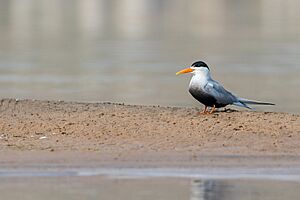Black-bellied tern facts for kids
Quick facts for kids Black-bellied tern |
|
|---|---|
 |
|
| Conservation status | |
| Scientific classification |
The black-bellied tern (Sterna acuticauda) is a special bird that lives near big rivers. You can find it in countries like Pakistan, India, and Myanmar. Sadly, there aren't many of these birds left, especially in the eastern parts of its home. Because of this, experts say it is an endangered animal.
These terns have a black belly during the summer. They also have a tail that looks like a deep fork. They might look a bit like other birds called whiskered terns. But the black-bellied tern has a deeper forked tail and black feathers on its lower belly. This helps tell them apart from whiskered terns.
Contents
What Does the Black-Bellied Tern Look Like?
The black-bellied tern is about 32 to 35 cm (13 to 14 in) long. That's about the length of a ruler! When it's time for them to have babies, their feathers look very special. The top of their head and the back of their neck are black. Their upper body is a light grey color.
Their throat is white, and their chest is light grey. This grey color slowly turns into a black belly. They have long, thin, and pointy wings. Their tail is deeply forked, with sharp tips. Their beak and feet are yellow or orange, and their eyes are reddish-brown. When it's not breeding season, their belly is whitish, and their tail is shorter. Their beak also has a dark tip.
Where Do Black-Bellied Terns Live?
You can mostly find black-bellied terns in Pakistan, Nepal, India, and Bangladesh. There's also another group of them in Myanmar. They like to live near rivers and wet areas called marshes. Sometimes, you might see them near ditches and small pools. They live in low areas, up to about 730 m (2,400 ft) high. These birds always stay inland and do not live near the coast.
How Do Black-Bellied Terns Live?
Even though black-bellied terns have long wings, they fly slowly. They flap their wings a lot. They eat insects and small fish. They fly low over the water or ground to pick up insects. They also dive into the water to catch small crabs, tadpoles, and fish.
They usually lay their eggs between February and April. They like to build their nests on flat, sandy spots near a river or lake. Sometimes they choose a sand spit or a sandy island. They don't nest in big groups by themselves. But they might nest near other birds like river terns, pratincoles, and Indian skimmers.
Why Are Black-Bellied Terns Endangered?
The black-bellied tern is an endangered bird. This means there are not many left, and they are at risk of disappearing forever. The places where they live and have their babies are being harmed in many parts of Asia. Even though they used to live in many places, they are now thought to be gone from southern China, Nepal, Thailand, Laos, Cambodia, and Vietnam.
Only in Pakistan, India, and Bangladesh are there still larger groups of these birds. But even in these countries, their numbers are going down fast. There might be fewer than one thousand adult black-bellied terns left in the world.
These birds face many dangers:
- The islands and sandspits where they nest are getting damaged.
- People sometimes collect their eggs for food.
- Dogs, cats, and crows can eat their eggs and chicks.
- Dams built on rivers can cause floods that wash away their nests.
- Fishermen sometimes compete with them for fish.
- They can get caught in fishing nets.
- People disturbing their nesting areas.
- Taking too much water from rivers.
- Digging up sand and gravel from rivers.
- Pollution in the water.


